The USS Carl Vinson (CVN-70) received the Navy’s first Joint Precision Approach and Landing System (JPALS) production unit in April, the service revealed Tuesday.
The first JPALS was delivered almost a month ahead of schedule and is one of a planned 23 initial low-rate initial production JPALS units being delivered through fall 2023.

In 2019, the Navy awarded Raytheon Technologies [RTX] a $235 million contract for the first 23 JPALS to outfit carriers and amphibious assault ships (Defense Daily, May 24, 2019).
JPALS is a GPS-based precision landing system integrating shipboard air traffic control and landing system architecture to guide aircraft to the carrier and amphibious assault ships “with pinpoint approach and landing,” the Navy said.
The system also includes anti-jam protection to operate in electronic warfare environments.
The Navy said installation and operational verification testing of JPALS on CVN-70 is scheduled to be finished by June. The system’s initial operating capability is scheduled for 2024 and full operational capability for 2030.
“JPALS provides the next generation of shipboard precision landing capability to ensure our warfighters can operate safely anywhere in the world, regardless of sea state or weather conditions. JPALS not only contributes to the safety and mission success of our aviators, but it will also provide the precision capability required to safely land the MQ-25 unmanned carrier-based aircraft on ships at sea in the future,” Capt Kevin Watkins, Naval Air Traffic Management Systems program manager, said in a statement.
Last September, Raytheon said it conducted a rapid setup demonstration of a land-based expeditionary version of JPALS at Naval Air Station Patuxent River, Md. (Defense Daily, Sept. 20, 2019).
JPALS demonstrations began in 2008, the first JPALS carrier landing occurred in 2013, and thus far five JPALS engineering and development models have been installed and tested on carriers and amphibious ships.